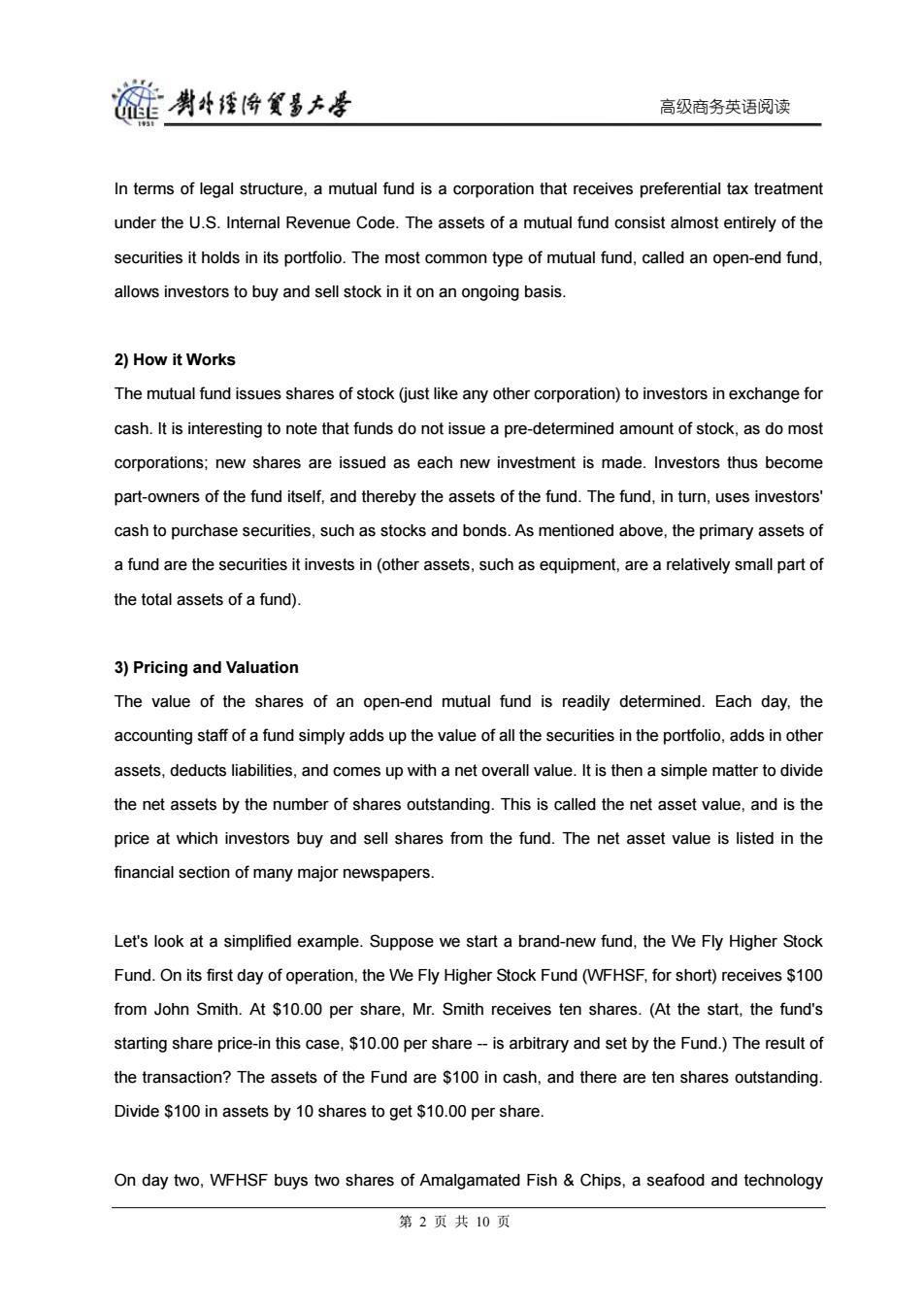正在加载图片...

链男牛经海食多大学 高级商务英语阅读 In terms of legal structure,a mutual fund is a corporation that receives preferential tax treatment under the U.S.Internal Revenue Code.The assets of a mutual fund consist almost entirely of the securities it holds in its portfolio.The most common type of mutual fund,called an open-end fund, allows investors to buy and sell stock in it on an ongoing basis. 2)How it Works The mutual fund issues shares of stock(just like any other corporation)to investors in exchange for cash.It is interesting to note that funds do not issue a pre-determined amount of stock,as do most corporations;new shares are issued as each new investment is made.Investors thus become part-owners of the fund itself,and thereby the assets of the fund.The fund,in turn,uses investors' cash to purchase securities,such as stocks and bonds.As mentioned above,the primary assets of a fund are the securities it invests in(other assets,such as equipment,are a relatively small part of the total assets of a fund). 3)Pricing and Valuation The value of the shares of an open-end mutual fund is readily determined.Each day,the accounting staff of a fund simply adds up the value of all the securities in the portfolio,adds in other assets,deducts liabilities,and comes up with a net overall value.It is then a simple matter to divide the net assets by the number of shares outstanding.This is called the net asset value,and is the price at which investors buy and sell shares from the fund.The net asset value is listed in the financial section of many major newspapers. Let's look at a simplified example.Suppose we start a brand-new fund,the We Fly Higher Stock Fund.On its first day of operation,the We Fly Higher Stock Fund (WFHSF,for short)receives $100 from John Smith.At $10.00 per share,Mr.Smith receives ten shares.(At the start,the fund's starting share price-in this case,$10.00 per share--is arbitrary and set by the Fund.)The result of the transaction?The assets of the Fund are $100 in cash,and there are ten shares outstanding. Divide $100 in assets by 10 shares to get $10.00 per share. On day two,WFHSF buys two shares of Amalgamated Fish Chips,a seafood and technology 第2页共10页高级商务英语阅读 In terms of legal structure, a mutual fund is a corporation that receives preferential tax treatment under the U.S. Internal Revenue Code. The assets of a mutual fund consist almost entirely of the securities it holds in its portfolio. The most common type of mutual fund, called an open-end fund, allows investors to buy and sell stock in it on an ongoing basis. 2) How it Works The mutual fund issues shares of stock (just like any other corporation) to investors in exchange for cash. It is interesting to note that funds do not issue a pre-determined amount of stock, as do most corporations; new shares are issued as each new investment is made. Investors thus become part-owners of the fund itself, and thereby the assets of the fund. The fund, in turn, uses investors' cash to purchase securities, such as stocks and bonds. As mentioned above, the primary assets of a fund are the securities it invests in (other assets, such as equipment, are a relatively small part of the total assets of a fund). 3) Pricing and Valuation The value of the shares of an open-end mutual fund is readily determined. Each day, the accounting staff of a fund simply adds up the value of all the securities in the portfolio, adds in other assets, deducts liabilities, and comes up with a net overall value. It is then a simple matter to divide the net assets by the number of shares outstanding. This is called the net asset value, and is the price at which investors buy and sell shares from the fund. The net asset value is listed in the financial section of many major newspapers. Let's look at a simplified example. Suppose we start a brand-new fund, the We Fly Higher Stock Fund. On its first day of operation, the We Fly Higher Stock Fund (WFHSF, for short) receives $100 from John Smith. At $10.00 per share, Mr. Smith receives ten shares. (At the start, the fund's starting share price-in this case, $10.00 per share -- is arbitrary and set by the Fund.) The result of the transaction? The assets of the Fund are $100 in cash, and there are ten shares outstanding. Divide $100 in assets by 10 shares to get $10.00 per share. On day two, WFHSF buys two shares of Amalgamated Fish & Chips, a seafood and technology 第 2 页 共 10 页